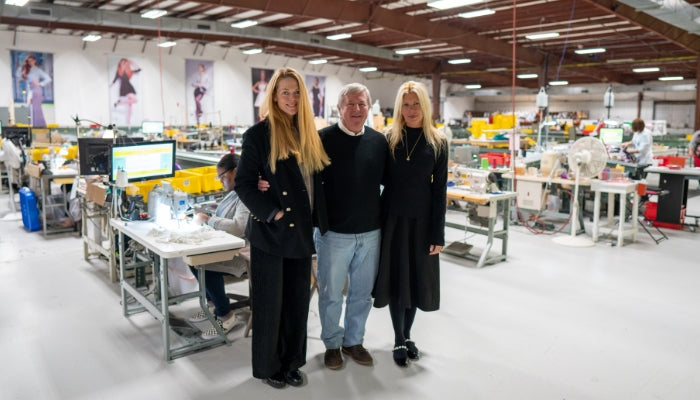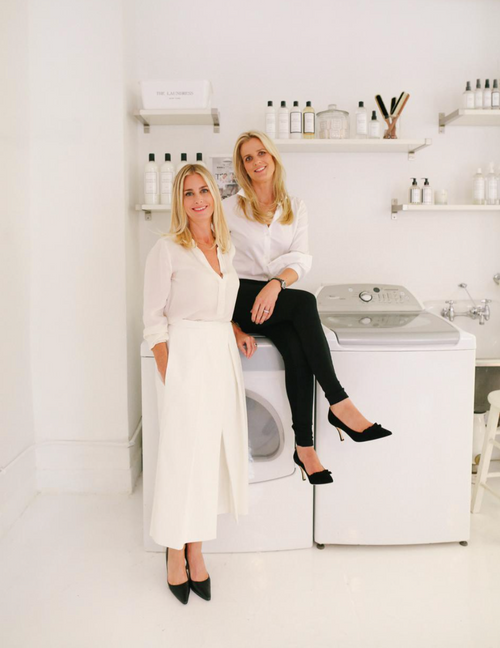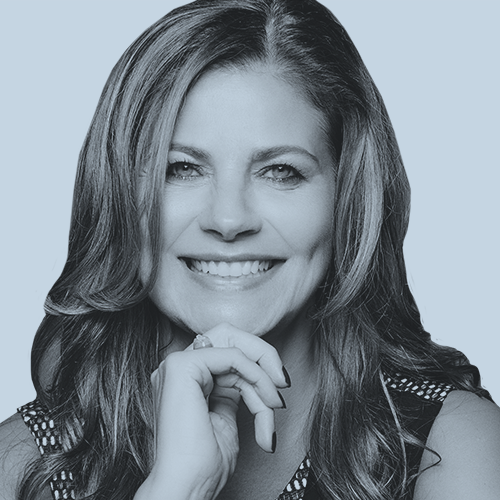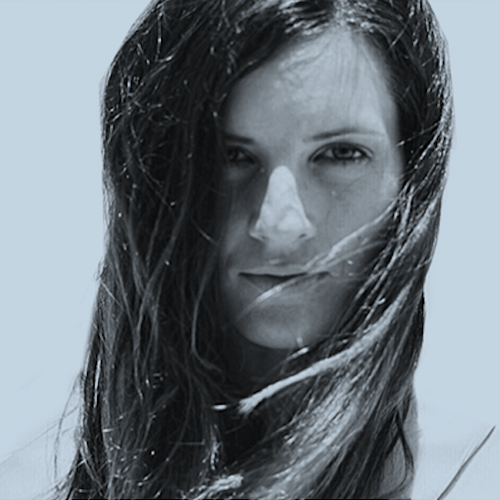
On-Demand Manufacturing
Kirby Best, the visionary founder of OnPoint Manufacturing, talks about the future of fashion and on-demand manufacturing.
TELL ME ABOUT ONPOINT MANUFACTURING. HOW ARE YOU DIFFERENT FROM TRADITIONAL CLOTHING MANUFACTURERS?
OnPoint Manufacturing is an on-demand apparel manufacturer. We are quite different from traditional clothing manufacturers in that we only produce a garment after it has been ordered by a customer. We specialize in a minimum order of one, and we help facilitate personalization and made to measure.
As there are more and more reports of the unfair treatment of workers (and the horrible conditions they work in) in the apparel manufacturing industry, it was extremely important that we offer our sewers a competitive living wage that is higher than minimum wage, give them access to healthcare benefits and most importantly give them a safe and friendly work environment. Our manufacturing plant is very thoughtfully laid out, both to maximize efficiencies on the production floor, and to create a safe and open environment for our employees. We welcome anyone to visit OPM and take a tour. We love to show off what we do!
HOW IS YOUR BUSINESS RELEVANT FROM A SUSTAINABILITY STANDPOINT?
Waste in the industry is rampant – from over production to transportation. By using an on-demand model, our customers no longer need to order hundreds of something that they may never sell. Instead they only order what they need. With on-demand manufacturing there is no inventory, no fabric waste, and no warehousing. By opting for OPM’s fulfillment services the factory ships direct to the consumer thereby limiting the handling of the garment, which reduces the overall carbon footprint.
HOW DOES YOUR TECHNOLOGY WORK? IS THE KEY DIFFERENTIATOR FOR ONPOINT THE SOFTWARE YOU HAVE DEVELOPED OR THE BUSINESS PRACTICES YOU APPLY?
Our technology works to support the designers in a way that allows them to affordably bring their product to market in the shortest amount of time. They supply OPM with a tech pack, which initiates the set-up process. Once their product is active in OPM’s system the designer can begin to sell that garment. When an order is received the technology takes over and organizes the cutting, sewing, and packaging of each order in the most efficient and timeliest manner. The system is designed to optimize the automated and the manual processes. The key differentiator is the software, but it is the fact that we “allow” the software to do what it’s designed to do, and resist interfering with the process that brings the solution to fruition. To be clear our sewing team still sews each garment the traditional way but everything else is 100% automated and driven by our unique software.
HOW DIFFICULT IS IT FOR OTHER MANUFACTURERS TO MOVE TOWARDS AN ON-DEMAND PRODUCTION MODEL? WHAT ARE THE MOST PROHIBITIVE FACTORS?
OPM has been working for a decade to refine its on-demand model and continues to push technology to its limits by utilizing all of the leading-edge hardware and software, partnering with industry leaders, and working closely with the design community to make it better. This accumulated knowledge and investment in relationships would be challenging to duplicate. OPM is a strong advocate for industry standardization so that others can economically embrace the on-demand platform and build a more responsive and responsible manufacturing community.
DO YOU BELIEVE ON-DEMAND MANUFACTURING WILL PLAY AN INCREASINGLY LARGE ROLE WITHIN THE INDUSTRY? DO YOU SEE A FUTURE WHERE MOST CLOTHING MANUFACTURING WILL BE ON-DEMAND? IF SO, HOW LONG FROM NOW?
On-demand manufacturing is most definitely here to stay and will become a more significant factor in the industry. The book manufacturing industry is about 10 years ahead of the garment industry in the proliferation of on-demand. Publishers initially resisted and have now whole-heartedly adopted the platform in combination with long-run offset printing. I see our industry following a similar pattern. When you shift the focus from the cost of making a garment to the cost of a garment sold the model begins to make so much sense. That paradigm shift takes time and proof, and I would suggest that the tipping point is around the corner. When? Soon!

HOW EVOLVED IS ON-DEMAND MANUFACTURING IN THE US VS. OTHER COUNTRIES?
OPM is the global leader in on-demand technology which is focused on digital patterns flowing directly into the factory and shipping garments directly out to a customer with minimal human intervention. There are plants in Asia that claim to custom make each order, but their operation is not as automated and is not focused on being all-inclusive for the design community.
TELL US WHY YOU DECIDED TO BASE YOUR OPERATIONS IN ALABAMA. ARE THERE PROS AND CONS TO THIS LOCATION?
OPM chose Florence Alabama because of its deep-rooted history in cut and sew manufacturing. We are in excellent company with Billy Reid and Alabama Chanin also headquartered in Florence. One of the driving forces was the pool of custom sewing talent that the area offers, which is critical to the top-quality garments that we strive to make every day. We are also well supported by the local business, academic, and public sector in Alabama. We were named the Alabama Manufacturer of the Year in 2019, and continue to partner with the vibrant and talented fashion community in. We don’t encounter many cons to our decision to locate in Alabama, although as a Canadian, I find it really hot in the summer!
YOU WERE AN OLYMPIC ATHLETE, REPRESENTING CANADA IN SKIING AND BOBSLEDDING? HOW HAS YOUR BACKGROUND AS AN ATHLETE INFLUENCED THE REST OF YOUR CAREER?
My experience with high level, performance sports was pivotal is peaking my interest in clothing and its form and function. We were fortunate to have sponsors that equipped us with garments made from (at the time) fabrics that could wick moisture and control odor, both great qualities that we take for granted today but that were a novelty back then. That exposure to performance clothing is what drove me to create our first garment, sleepwear, made out of moisture wicking fabric. Speed was central in so many sports just as speed to market is our focus today. Of course sports prepared me to train hard, partner wisely, and persevere, which is directly applicable to my business career!

HOW DID YOU BECOME INTERESTED IN CLOTHING MANUFACTURING, AND, IN PARTICULAR, IN ON-DEMAND MANUFACTURING?
The majority of my business career was in book manufacturing. I was instrumental in building the world’s largest print-on-demand plant and “disrupting” that industry. About 20 years ago I took a keen interest in clothing manufacturing because my wife had a need for sleepwear that would allow her to sleep through the night without the devastating effect of night sweats and that garment didn’t exist. That was really the beginning of our clothing design business, and again, out of necessity, I engineered an on-demand plant so that designers like us, who were small, could cost effectively enter the market. The idea grew, like it did with books, to challenge the garment industry to manufacture in the United States and look at profitability and sustainability from new angles. And to show that the industry can prosper this way and reach the talented artists who want to use their design school degree to make clothes that get sold and worn.
WHAT IS NEXT FOR ONPOINT? ARE YOU PURSUING TECHNOLOGICAL ADVANCES WE CAN SOON EXPECT? OTHER IMPORTANT DEVELOPMENTS?
We have an exciting year ahead. By late Q2, we will be printing direct-to-fabric. We have always been working toward a complete end-to-end solution and with the addition of the Kornit Presto printer, we’ll be able to feed printed fabric directly into our Gerber Z1 cutter and then through our manufacturing line all with the same three-to-five-day turnaround times we offer now. We are also working on a number of technological improvements that will allow us, with proper tech packs, to set a garment up in our system in a matter of minutes. That will make our turnaround times even faster than today. We are also working on building our second factory in 2020.

CONSIDER THE FASHION INDUSTRY A DECADE FROM NOW IN THE YEAR 2030.
WHAT WOULD YOU HOPE TO SEE?
I hope that the fashion industry has reached a stage where it is accessible to all artists who have a design idea. I hope that the consumer is at the center of the industry, has the clothes that fit them, and has a hand in personalizing. I also hope to see that our standard sizing system has disappeared and has been replaced by custom-fit garments. I hope that the industry is no longer dumping unsold garments into landfills, and that we can pay our talented sewers competitive wages in work environments that are healthy. And I hope that we have many factories in the United States, and around the world, crafting beautiful sustainable clothing for some amazing brands like Katla Clothing.
It has been a real honor partnering with Katla. You share in our vision of there being a more eco-friendly way to make apparel. It starts with being conscious of the fabrics chosen, and continues through the manufacturing and fulfillment processes. I look forward to collaborating on more and more projects together as we work toward the common goal of making sustainability in the fashion industry the norm and not the exception.











